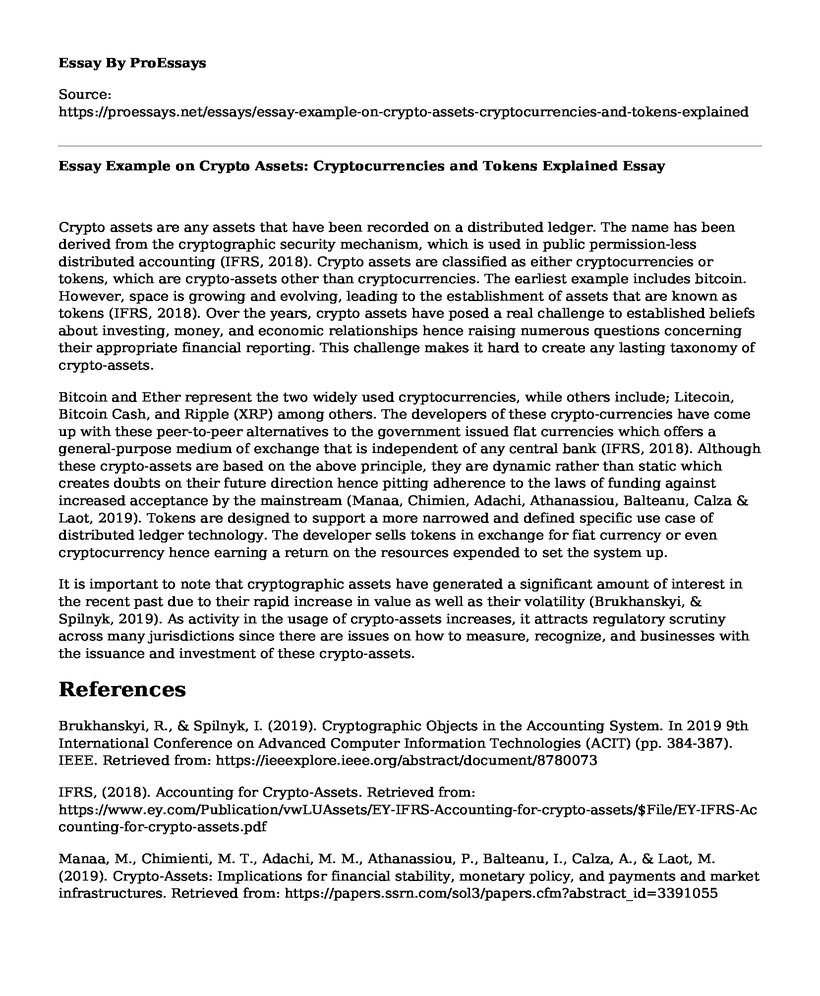Crypto assets are any assets that have been recorded on a distributed ledger. The name has been derived from the cryptographic security mechanism, which is used in public permission-less distributed accounting (IFRS, 2018). Crypto assets are classified as either cryptocurrencies or tokens, which are crypto-assets other than cryptocurrencies. The earliest example includes bitcoin. However, space is growing and evolving, leading to the establishment of assets that are known as tokens (IFRS, 2018). Over the years, crypto assets have posed a real challenge to established beliefs about investing, money, and economic relationships hence raising numerous questions concerning their appropriate financial reporting. This challenge makes it hard to create any lasting taxonomy of crypto-assets.
Bitcoin and Ether represent the two widely used cryptocurrencies, while others include; Litecoin, Bitcoin Cash, and Ripple (XRP) among others. The developers of these crypto-currencies have come up with these peer-to-peer alternatives to the government issued flat currencies which offers a general-purpose medium of exchange that is independent of any central bank (IFRS, 2018). Although these crypto-assets are based on the above principle, they are dynamic rather than static which creates doubts on their future direction hence pitting adherence to the laws of funding against increased acceptance by the mainstream (Manaa, Chimien, Adachi, Athanassiou, Balteanu, Calza & Laot, 2019). Tokens are designed to support a more narrowed and defined specific use case of distributed ledger technology. The developer sells tokens in exchange for fiat currency or even cryptocurrency hence earning a return on the resources expended to set the system up.
It is important to note that cryptographic assets have generated a significant amount of interest in the recent past due to their rapid increase in value as well as their volatility (Brukhanskyi, & Spilnyk, 2019). As activity in the usage of crypto-assets increases, it attracts regulatory scrutiny across many jurisdictions since there are issues on how to measure, recognize, and businesses with the issuance and investment of these crypto-assets.
References
Brukhanskyi, R., & Spilnyk, I. (2019). Cryptographic Objects in the Accounting System. In 2019 9th International Conference on Advanced Computer Information Technologies (ACIT) (pp. 384-387). IEEE. Retrieved from: https://ieeexplore.ieee.org/abstract/document/8780073
IFRS, (2018). Accounting for Crypto-Assets. Retrieved from: https://www.ey.com/Publication/vwLUAssets/EY-IFRS-Accounting-for-crypto-assets/$File/EY-IFRS-Accounting-for-crypto-assets.pdf
Manaa, M., Chimienti, M. T., Adachi, M. M., Athanassiou, P., Balteanu, I., Calza, A., & Laot, M. (2019). Crypto-Assets: Implications for financial stability, monetary policy, and payments and market infrastructures. Retrieved from: https://papers.ssrn.com/sol3/papers.cfm?abstract_id=3391055
Cite this page
Essay Example on Crypto Assets: Cryptocurrencies and Tokens Explained. (2023, Feb 09). Retrieved from https://proessays.net/essays/essay-example-on-crypto-assets-cryptocurrencies-and-tokens-explained
If you are the original author of this essay and no longer wish to have it published on the ProEssays website, please click below to request its removal:
- Voluntary Income Tax Assistance Essay
- Swiss Proposal of Amending Banking Practice as We Know It Essay
- The Process of Budgeting in Nursing Paper Example
- Research Paper on Investment Process: Risk Communication & Analysis
- Inheriting $$$: Investing in Government Securities & Real Estate - Essay Sample
- Essay Example on Current US GDP & Federal Debt: 85.91 Trillion & ~23.17 Trillion Respectively
- Essay Sample on Taxpayers Compensated for Welfare Programs







